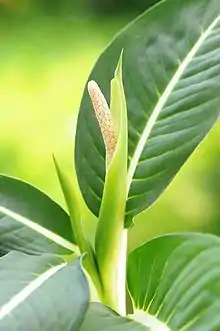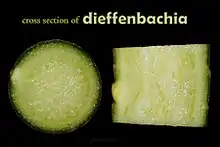Dieffenbachia
Dieffenbachia /ˌdiːfɪnˈbækiə/[2] is a genus of tropical flowering plants in the family Araceae. It is native to the New World Tropics from Mexico and the West Indies south to Argentina. Some species are widely cultivated as ornamental plants, especially as houseplants, and have become naturalized on a few tropical islands.[1][3][4]
| Dieffenbachia (dumb cane) | |
|---|---|
 | |
| Dieffenbachia oerstedii at Chicago Botanic Garden | |
| Scientific classification | |
| Kingdom: | Plantae |
| Clade: | Tracheophytes |
| Clade: | Angiosperms |
| Clade: | Monocots |
| Order: | Alismatales |
| Family: | Araceae |
| Subfamily: | Aroideae |
| Tribe: | Dieffenbachieae |
| Genus: | Dieffenbachia Schott |
 | |
| Range of the genus Dieffenbachia. | |
| Synonyms[1] | |
| |
Dieffenbachia is a perennial herbaceous plant with straight stem, simple and alternate leaves containing white spots and flecks, making it attractive as indoor foliage. Species in this genus are popular as houseplants because of their tolerance of shade. Its English names, dumb cane and mother-in-law's tongue (also used for Sansevieria species) refer to the poisoning effect of raphides, which can cause temporary inability to speak.[5] Dieffenbachia was named by Heinrich Wilhelm Schott, director of the Botanical Gardens in Vienna, to honor his head gardener Joseph Dieffenbach (1796–1863).


Species
The World Checklist of Selected Plant Families lists the following species:[1]
- Dieffenbachia aglaonematifolia Engl. – Brazil, Paraguay; Corrientes + Misiones Provinces of Argentina
- Dieffenbachia antioquensis Linden ex Rafarin – Colombia
- Dieffenbachia aurantiaca Engl – Costa Rica, Panama
- Dieffenbachia beachiana Croat & Grayum – Costa Rica, Panama
- Dieffenbachia bowmannii Carrière – Colombia, northwestern Brazil
- Dieffenbachia brittonii Engl. – Colombia
- Dieffenbachia burgeri Croat & Grayum – Costa Rica
- Dieffenbachia cannifolia Engl. – Colombia, Ecuador, Peru
- Dieffenbachia concinna Croat & Grayum – Costa Rica, Nicaragua
- Dieffenbachia copensis Croat – Panama
- Dieffenbachia cordata Engl. – Peru
- Dieffenbachia costata Klotzsch ex Schott – Colombia, Ecuador, Peru
- Dieffenbachia crebripistillata Croat – Panama
- Dieffenbachia daguensis Engl. – Colombia, Ecuador
- Dieffenbachia davidsei Croat & Grayum – Costa Rica
- Dieffenbachia duidae (Steyerm.) G.S.Bunting – Venezuela, Guyana
- Dieffenbachia elegans A.M.E.Jonker & Jonker – Bolivia, northwestern Brazil, the Guianas
- Dieffenbachia enderi Engl. – Colombia
- Dieffenbachia fortunensis Croat – Panama
- Dieffenbachia fosteri Croat – Panama
- Dieffenbachia fournieri N.E.Br. – Colombia
- Dieffenbachia galdamesiae Croat – Panama
- Dieffenbachia gracilis Huber – Peru, northwestern Brazil
- Dieffenbachia grayumiana Croat – Costa Rica, Panama, Colombia
- Dieffenbachia hammelii Croat & Grayum – Costa Rica, Nicaragua
- Dieffenbachia herthae Diels – Ecuador
- Dieffenbachia horichii Croat & Grayum – Costa Rica
- Dieffenbachia humilis Poepp. – Bolivia, Peru, Ecuador, northwestern Brazil, the Guianas
- Dieffenbachia imperialis Linden & André – Peru
- Dieffenbachia isthmia Croat – Panama
- Dieffenbachia killipii Croat – Panama
- Dieffenbachia lancifolia Linden & André – Colombia
- Dieffenbachia leopoldii W.Bull – Colombia
- Dieffenbachia longispatha Engl. & K.Krause – Honduras, Nicaragua, Costa Rica, Panama, Colombia, Venezuela
- Dieffenbachia lutheri Croat – Panama
- Dieffenbachia macrophylla Poepp. – Peru
- Dieffenbachia meleagris L.Linden & Rodigas – Ecuador
- Dieffenbachia nitidipetiolata Croat & Grayum – Panama
- Dieffenbachia obliqua Poepp. – Peru
- Dieffenbachia obscurinervia Croat – Panama
- Dieffenbachia oerstedii Schott – southern Mexico (Veracruz, Tabasco, Campeche, Oaxaca, Chiapas), Central America (all 7 countries), Colombia
- Dieffenbachia olbia L.Linden & Rodigas – Peru
- Dieffenbachia paludicola N.E.Br. ex Gleason – northwestern Brazil, the Guianas, Venezuela
- Dieffenbachia panamensis Croat – Panama
- Dieffenbachia parlatorei Linden & André – Colombia, Venezuela
- Dieffenbachia parvifolia Engl. – northwestern Brazil, Bolivia, Ecuador, Peru, Venezuela
- Dieffenbachia pittieri Engl. & K.Krause – Panama
- Dieffenbachia seguine (Jacq.) Schott – West Indies, south to Brazil and Bolivia
- Dieffenbachia shuttleworthiana Regel – Colombia
- Dieffenbachia standleyi Croat – Honduras
- Dieffenbachia tonduzii Croat & Grayum – Nicaragua, Costa Rica, Panama, Colombia, Ecuador
- Dieffenbachia weberbaueri Engl. – Peru
- Dieffenbachia weirii Berk. – Colombia
- Dieffenbachia wendlandii Schott – southern Mexico (Querétaro, Veracruz, Oaxaca, Chiapas) south to Panama
- Dieffenbachia williamsii Croat – Bolivia
- Dieffenbachia wurdackii Croat – Peru
Dieffenbachia includes a number of unresolved taxonomic names, such as Dieffenbachia amoena.[6]
Ecology
In a survey which began in 1998, researchers in Costa Rica noticed that the strawberry poison frog Oophaga pumilio, deposited almost all (89%) of their tadpoles on the leaf axils of Dieffenbachia. As a result, the frog population fluctuated with the abundance of Dieffenbachia, especially in secondary forest. A majority of the plants were eradicated by 2012 when the surveyors returned to the same area, with only 28% of 2002 plant numbers remaining. Researchers concluded that the reason for the rapid decline in Dieffenbachia was due to increased abundance of the collared peccary Pecari tajacu in the La Selva Biological Station research area; a small pig-like animal which feeds on Dieffenbachia and other plants.[7]
Cultivation
With a minimum temperature of 5 °C (41 °F), dieffenbachia must be grown indoors in temperate areas. They need light, but filtered sunlight through a window is usually sufficient. They also need moderately moist soil, which should be regularly fertilized with a proprietary houseplant fertilizer. Leaves will periodically roll up and fall off to make way for new leaves. Yellowing of the leaves is generally a sign of problematic conditions, such as a nutrient deficiency in the soil. Dieffenbachia respond well to hot temperatures and dry climates.[8]
Dieffenbachia prefer medium sunlight, moderately dry soil and average home temperatures of 62–80 °F (17–27 °C). Most require water about twice a week.
As Dieffenbachia seguine comes from the tropical rain forest, it prefers to have moisture at its roots, as it grows all the time, it needs constant water, but with loose well aerated soils.[9]
The cultivars 'Camille'[10] and 'Tropic Snow'[11] have gained the Royal Horticultural Society's Award of Garden Merit.[12]
Toxicity
The cells of the Dieffenbachia plant contain needle-shaped calcium oxalate crystals called raphides. If a leaf is chewed, these crystals can cause a temporary burning sensation and erythema. In rare cases, edema of tissues exposed to the plant has been reported. Mastication and ingestion generally result in only mild symptoms.[13] With both children and pets, contact with dieffenbachia (typically from chewing) can cause a host of unpleasant symptoms, including intense numbing, oral irritation, excessive drooling, and localized swelling.[14] However, these effects are rarely life-threatening. In most cases, symptoms are mild, and can be successfully treated with analgesic agents,[15] antihistamines,[16] or medical charcoal.[17][18] Moreover, severe cases can occur if Dieffenbachia makes prolonged contact with oral mucosal tissue. In such cases, symptoms generally include severe pain which can last for several days to weeks. Hospitalization may be necessary if prolonged contact is made with the throat, in which severe swelling has the potential to affect breathing. Gastric evacuation or lavage is "seldom"[17] indicated. In patients with exposure to toxic plants, 70% are children younger than 5 years.
Stories that Dieffenbachia is a deadly poison are urban legends.[19]
 A 47 year old 9.75 foot tall Dieffenbachia house plant
A 47 year old 9.75 foot tall Dieffenbachia house plant A large dieffenbachia with big bright green leaves on display as a houseplant
A large dieffenbachia with big bright green leaves on display as a houseplant Dieffenbachia shoot
Dieffenbachia shoot Dieffenbachia crossview
Dieffenbachia crossview
References
- Kew World Checklist of Selected Plant Families
- Sunset Western Garden Book. 1995. pp. 606–7. ISBN 978-0-376-03851-7.
- Govaerts, R. & Frodin, D.G. (2002). World Checklist and Bibliography of Araceae (and Acoraceae): 1–560. The Board of Trustees of the Royal Botanic Gardens, Kew.
- Croat, Thomas B. (December 2004). "Revision of Dieffenbachia (Araceae) of Mexico, Central America, and the West Indies". Annals of the Missouri Botanical Garden. 91 (4): 668–772. JSTOR 3298554.
- "Dumb cane | plant". Encyclopedia Britannica.
- "Dieffenbachia — The Plant List". www.theplantlist.org. Retrieved 2018-12-21.
- McKone, Mark J.; Moore, Jonathan W.; Harbison, Christopher W.; Holmen, Ian C.; Lyons, Hillary C.; Nachbor, Kristine M.; Michalak, Julia L.; Neiman, Maurine; Nicol, Julia L.; Wheeler, George R. (2014). "Rapid collapse of a population of Dieffenbachia spp., plants used for tadpole-rearing by a poison-dart frog (Oophaga pumilio) in a Costa Rican rain forest". Journal of Tropical Ecology. 30 (6): 615–619. doi:10.1017/S0266467414000467. ISSN 0266-4674.
- MacDonald, Elvin "The World Book of House Plants" Popular Books
- "Dieffenbachia seguine". plantsrescue.com. Retrieved 18 December 2016.
- "RHS Plantfinder – Dieffenbachia 'Camille'". Retrieved 12 February 2018.
- "RHS Plantfinder – Dieffenbachia 'Tropic Snow'". Retrieved 12 February 2018.
- "AGM Plants – Ornamental" (PDF). Royal Horticultural Society. July 2017. p. 16. Retrieved 24 January 2018.
- Mrvos, Rita; Dean, Bonnie S.; Krenzelok, Edward P. (1991). "Philodendron/Dieffenbachia Ingestions: Are They a Problem?". Clinical Toxicology. 29 (4): 485–91. doi:10.3109/15563659109025745. PMID 1749055.
- "Dieffenbachia". ASPCA.
- Plant Poisoning, Caladium, Dieffenbachia, and Philodendron at eMedicine
- GN Lucas – Sri Lanka Journal of Child Health, 2008 – "Plant poisoning in Sri Lankan children: A hospital based prospective study" (PDF). Archived from the original (PDF) on July 16, 2011. Retrieved March 17, 2009.
- Lamminpää, Anne; Kinos, Marja (1996). "Plant poisonings in children". Human & Experimental Toxicology. 15 (3): 245–9. doi:10.1177/096032719601500310. PMID 8839213. S2CID 20090392.
- Šnajdauf, Jiří; Mixa, Vladimír; Rygl, Michal; Vyhnánek, Martin; Morávek, Jiří; Kabelka, Zdenĕk (2005). "Aortoesophageal fistula—an unusual complication of esophagitis caused by Dieffenbachia ingestion". Journal of Pediatric Surgery. 40 (6): e29–31. doi:10.1016/j.jpedsurg.2005.03.036. PMID 15991162.
- "Common Household Plant Dieffenbachia Deadly Poisonous?". snopes.com. Retrieved 17 June 2017.
Sources
- Schott, H. W. and Kunst, W. Z. (1829). Für Liebhaber der Botanik.
External links
| Wikimedia Commons has media related to Dieffenbachia. |
| Wikisource has the text of the 1920 Encyclopedia Americana article Dieffenbachia. |